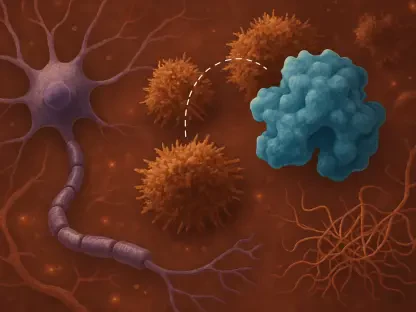RNA editing has long been a topic of fascination within the field of genetic research. Recent advancements by Wave Life Sciences have transformed this curiosity into a real-world application, with their trials showing promising results for treating alpha-1 antitrypsin deficiency (AATD). This breakthrough could pave the way for RNA editing to become a cornerstone of genetic therapy, offering hope to millions affected by genetic disorders. But what does this new frontier hold for patients, and could it finally address the challenges left unresolved by previous genetic therapies?
Understanding Alpha-1 Antitrypsin Deficiency (AATD)
What is AATD?
Alpha-1 antitrypsin deficiency is a genetic disorder characterized by insufficient levels of alpha-1 antitrypsin (AAT) protein in the blood. This condition predominantly affects the liver and the lungs, leading to severe respiratory issues and liver disease. AATD stems from mutations in the SERPINA1 gene, which encodes the AAT protein. These mutations cause the misfolding of the AAT protein, thereby impairing its ability to perform its protective role in the lungs and liver.
AATD affects approximately 1 in 5,000 people of European descent, making it one of the more common genetic disorders. The chronic nature of the disease significantly impacts the quality of life and necessitates lifelong medical care, highlighting the urgent need for effective treatments. As patients often require consistent and demanding medical upkeep, including frequent hospital visits and various symptomatic treatments, the burden on both individuals and healthcare systems is profound.
Traditional Treatment Approaches
Traditional treatments for AATD include intravenous administration of purified AAT from blood donors and supportive therapies like bronchodilators and corticosteroids. While these treatments help manage symptoms, they fall short of addressing the root genetic cause of the disorder. For many patients, these solutions provide only temporary relief, leading to a perpetual cycle of treatments without comprehensive long-term improvement.
Given the limitations of symptomatic treatments, there has been growing interest in genetic interventions that could offer more definitive solutions. However, these approaches have grappled with challenges like off-target effects and ethical concerns. For instance, CRISPR-based gene editing, one of the more high-profile genetic intervention strategies, has faced scrutiny over its potential for unintended genetic consequences and the ethical dilemmas posed by permanent DNA modifications. This backdrop makes the advent of RNA editing particularly compelling as it promises a safer and more controlled alternative.
The Evolution of RNA Editing
What is RNA Editing?
RNA editing involves altering the nucleotide sequence of RNA molecules. Unlike DNA editing, which makes permanent changes to the genome, RNA editing is temporary and reversible, allowing for more precise modulation of gene expression. This method involves the use of oligonucleotides, which are small strands of nucleic acids, delivered into cells to recruit specific enzymes responsible for editing the RNA.
Wave Life Sciences’ approach uses oligonucleotides delivered into cells via sugar molecules to recruit ADAR enzymes. These enzymes specifically edit single nucleotide bases in the RNA, correcting faulty protein-making instructions without altering the underlying DNA. This innovative technique allows for high precision in targeting only the defective RNA sequences, thereby reducing the risks associated with off-target effects and providing a more controlled therapeutic avenue.
Advantages Over CRISPR and Other Technologies
One of the significant advantages of RNA editing over CRISPR is its reversible nature. This reduces the risks associated with permanent genetic modifications, such as unintended genetic consequences. The ability to reverse and re-edit RNA sequences offers an additional safety layer, making this approach particularly appealing for clinical applications where long-term genetic stability is a concern.
RNA editing technologies like those developed by Wave Life Sciences can achieve high levels of precision, targeting specific RNA sequences without affecting other parts of the genome. This specificity minimizes off-target effects, making the therapy safer and more effective. The temporary nature of RNA modifications also allows for dynamic and responsive intervention strategies, which can be adjusted based on therapeutic needs over time without the lingering ramifications of permanent DNA edits.
Clinical Trial Milestones
Initial Success in Human Trials
Wave Life Sciences recently reported successful edits in the RNA of the first two patients treated in their clinical trial for AATD. These edits increased AAT protein levels significantly and demonstrated the therapy’s potential efficacy. The clinical trial marked the first instance of successful human RNA editing, setting a new benchmark in the field of genetic medicine by translating preclinical successes into tangible clinical outcomes.
Importantly, the treatment achieved these results with no serious side effects, bolstering confidence in RNA editing as a safe therapeutic option. Given the historical challenges faced by genetic therapies, which often encountered issues related to safety and adverse effects, this result is particularly noteworthy. It underscores the potential for RNA editing to provide a non-invasive yet robust alternative for genetic disorder treatment.
Detailed Mechanism and Outcomes
The oligonucleotides used in Wave’s technology effectively recruited ADAR enzymes to the target RNA, correcting the fault without disrupting other cellular functions. This precise editing mechanism ensured the production of the functional AAT protein. By targeting the RNA rather than the DNA, Wave’s technology could make significant corrections to the protein synthesis process, effectively bypassing the genetic mutation issues present in AATD patients and allowing for a closer approximation to normal physiological conditions.
Within just 15 days post-treatment, plasma concentrations of AAT protein met regulatory requirements for augmentation therapies, indicating not just symptomatic relief but a potential long-term solution to protein deficiency. The rapid improvement observed in patients also suggests the feasibility of this approach in providing timely therapeutic benefits, which is crucial for managing chronic and progressive conditions like AATD.
Market and Industry Response
Strategic Partnerships
Wave Life Sciences has established a strategic partnership with GSK for the further development and commercialization of their RNA editing therapies. The partnership could yield up to $525 million in milestone payments to Wave. This collaboration underscores the significant market potential and pharmaceutical industry interest in RNA editing, not just as a novel scientific achievement but as a commercially viable therapeutic option.
This collaboration is expected to accelerate the availability of RNA editing-based treatments, bringing them one step closer to clinical practice and making them accessible to patients worldwide. The involvement of GSK, with its extensive resources and global reach, could facilitate the rapid scaling and distribution of these new therapies, thereby maximizing their impact on a broader patient population.
Investor Confidence
Following the positive trial results, Wave’s stock surged by over 75%, reflecting strong market confidence in the potential of RNA editing technology. The stock market’s response serves as a bellwether for the broader investment community’s excitement and belief in the transformative potential of RNA editing. This surge has not only buoyed Wave Life Sciences but has also impacted the valuation and funding prospects of other companies working in the RNA editing space.
Other players in the RNA editing space, such as Korro Bio and ProQR, also experienced increased investor interest, underscoring the broader excitement and potential for RNA editing to revolutionize genetic therapies. As investment pours into this burgeoning field, the pace of innovation and clinical trials is likely to accelerate, further expanding the potential applications and efficacy of RNA editing technologies.
The Broader Implications of RNA Editing
Impact on Genetic Medicine
The success of Wave Life Sciences’ clinical trials could herald a new era in genetic medicine, where RNA editing becomes a mainstay therapeutic strategy. Unlike traditional genetic therapies, RNA editing offers a unique combination of reversibility, precision, and safety, which could make it preferable for treating a wide array of genetic disorders. This represents a significant paradigm shift in how genetic conditions are approached and managed, potentially reducing the reliance on symptom management and moving towards more curative interventions.
As companies continue to refine and improve these RNA editing techniques, the spectrum of treatable conditions could expand, offering new hope for patients with previously untreatable or poorly managed genetic diseases. These advancements could lead to personalized medicine approaches where treatments are tailored to the specific genetic profiles of patients, thereby optimizing efficacy and minimizing risks.
Ethical and Regulatory Considerations
While the potential of RNA editing is immense, it also brings with it a host of ethical and regulatory challenges. Policymakers and regulatory bodies will need to establish robust frameworks to ensure the safe and equitable deployment of these technologies. This includes addressing concerns about access, affordability, and the long-term monitoring of patients receiving RNA editing treatments.
Furthermore, ethical considerations regarding the extent and limitations of genetic modifications will need to be carefully navigated to prevent misuse or unintended consequences of this powerful technology. Ensuring that RNA editing is used responsibly and ethically will be paramount in maintaining public trust and support for these groundbreaking advancements.
Conclusion
RNA editing has captivated genetic researchers for years, and recent advancements have brought this concept closer to practical application. Wave Life Sciences is at the forefront of this movement, demonstrating significant promise in treating alpha-1 antitrypsin deficiency (AATD) through their innovative trials. This progress raises the potential for RNA editing to become an essential element of genetic therapy, offering fresh hope to millions affected by various genetic disorders. The successful application of RNA editing for AATD could serve as a model for addressing other genetic challenges that previous therapies couldn’t resolve.
As the field evolves, the implications for patients are immense. RNA editing offers the precision of altering specific genetic sequences, which could result in more effective treatments with fewer side effects compared to traditional methods. This level of accuracy not only improves patient outcomes but also opens up new avenues for treating a wide array of genetic conditions that were previously deemed untreatable.
The advancements made by Wave Life Sciences are a testament to the enormous potential of RNA editing. If these early successes are any indication, the future could see RNA editing becoming a standard practice in the treatment of many genetic disorders. As we stand on the brink of this new frontier, it’s clear that a new chapter in genetic therapy is just beginning, promising to tackle unmet medical needs and significantly improve the quality of life for many.









